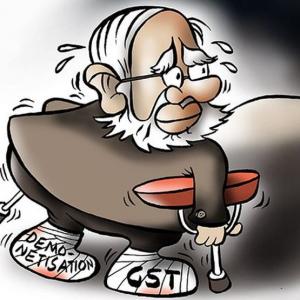The need of the hour is to strike a balance between the capability of the conventional and the prospect of the renewable to give a realistic shape to the Prime Minister’s vision, says Rajiv Mishra.
Illustration: Uttam Ghosh/Rediff.com

The India story, which predominantly reflects the way the economy is shaping up, is largely hinged to the power sector that is rapidly turning out to be the real-life force behind all developmental intents and initiatives.
An increasing population and accelerated economic growth have consequently led to a surge in the demand for power to support the country’s urbanisation and industrialisation programmes.
India has had a worrisome past as far as its power sector is concerned: a track record marred by poor generation capability, missed capacity addition targets, inadequate and dilapidated transmission network, overburdened distribution system and leaping debts.
But this situation has seen a turnaround in the last three-and-a-half years.
At the United Nations Climate Change Conference or COP-21 in Paris in December 2015, India made a pledge to address the growing energy demands with sources that were low on emissions.
The pledge stated that India will reduce CO2 emissions intensity by 33 per cent-35 per cent of the GDP by 2030.
This was followed up with targets to boost the share of non-fossil fuel driven generation capacity to 40 per cent by 2030.
A compelling story
The government’s current policies and regulations for the power sector are being conceived with an eye on Prime Minister Narendra Modi’s vision of ‘Power for All’ -- an ambitious target of ensuring electricity for every household by 2022.
The renewable energy sector is gaining momentum; driven initially by incentives like generation-based incentives capital and interest subsidies, viability gap funding etc., but now driven purely by transparent competitive bidding to meet the target of generating 175 Gw by 2022.
India’s installed capacity from renewable energy sources stands at almost 16 per cent of the total capacity as of February 2017.
The intent can be seen being replicated in other Asian markets like China and Indonesia.
China has set an interim target of increasing the share of gas to 10 per cent by 2020 and boosting the contribution of non-fossil fuel energy to 20 per cent by 2030.
Indonesia has a target to increase the share of renewable energy to its energy mix from 6 per cent in 2012 to at least 23 per cent by 2025.
The private sector has led the development of renewable energy in India. Recent bids for solar and wind power projects have seen record-low tariffs and India’s total installed renewable capacity has increased to 58,303 Mw.
A unique nation with distinctive need
The current pattern of development of the power sector indicates that India’s power story, while resonating the global trend of zero-emission sources dominating energy base, will chart a unique course for itself.
India will perhaps be one of the few major countries that will see a significant addition in the conventional energy space vis-à-vis renewable and clean energy: 258 Gw of coal-driven power capacity addition and 79 Gw of cumulative capacity from gas power as per Bloomberg New Energy Finance’s New Energy Outlook Report 2016.
This is understandable given India’s electricity demand which is expected to grow at approximately 7 per cent per annum to almost 5000 Twh/year in the next 20 years.
In comparison, the electricity consumption in the United States and Europe, which represent 40 per cent of global demand, has been declining over the recent years, while demand is largely expected to stay flat.
Another reason for India’s continuing emphasis on the conventional power segment is the high investments already made.
Approximately Rs 500 billion has been invested by FDIs in the last 16 years in various coal-based and gas-based projects.
A radical transition to clean and renewable energy will impact the viability of these investments.
There is also the crucial matter of coal that is found predominantly in the poorer, eastern parts of the country, with the livelihood of millions of people dependent on it. Paradoxically, coal is also the source of what the Economic Survey 2016-17 termed as the “resource curse” -- crime, corruption, mafia, Maoist violence, etc.
It is therefore important that the inevitable -- and welcome -- transition away from conventional sources take place at a measured pace.
Unlocking the potential through synergy
At the 2015 COP 21, all 195 participating states and the European Union agreed to cut emissions.
While the developed countries started formulating their policies for the cause, developing countries, including India, embarked upon a path to drastically change the way energy is being generated.
From policy interventions to private sector making individual efforts, the goals are being worked towards in a systematic manner.
In this context, the need of the hour is to strike a balance between the capability of the conventional and the prospect of the renewable to give a realistic shape to the Prime Minister’s vision, and adopt a staggered approach for the transition.
Measures like pushing the current thermal capacity to affect the use of supercritical technology in the short term switching to gas power will increase energy efficiency and prepare the springboard for India to take off when the time comes.
And all this can be done while ensuring higher returns on investments for the existing capacities.
The private sector is already working towards achieving the synergy between the two.
The prominent producers are responsibly diversifying their power portfolio to prepare a platform for a gradual but steady shift from conventional to renewable energy.
Conscious efforts are being made to create a hybrid mix of renewable and conventional sources of generating power.
The same theme continued at the recently concluded COP 23 in Bonn.
The participating countries -- including a strong states-led delegation from the United States -- resolved that the ‘Talanoa Dialogue’, inspired by the Pacific concept of constructive discussion, debate and story-telling, will set the stage in Poland in 2018 for the upward revision of national climate action plans needed to put the world on track to meet pre-2020 ambition and the long-term goals of the two-year old Paris Agreement.
The countries also made some other achievements, including an agreement on agriculture and others on a Gender Action Plan and Indigenous People’s Platform.
Rajiv Mishra is chairman, Economic Advisory Council to the Prime Minister. Views are personal.










